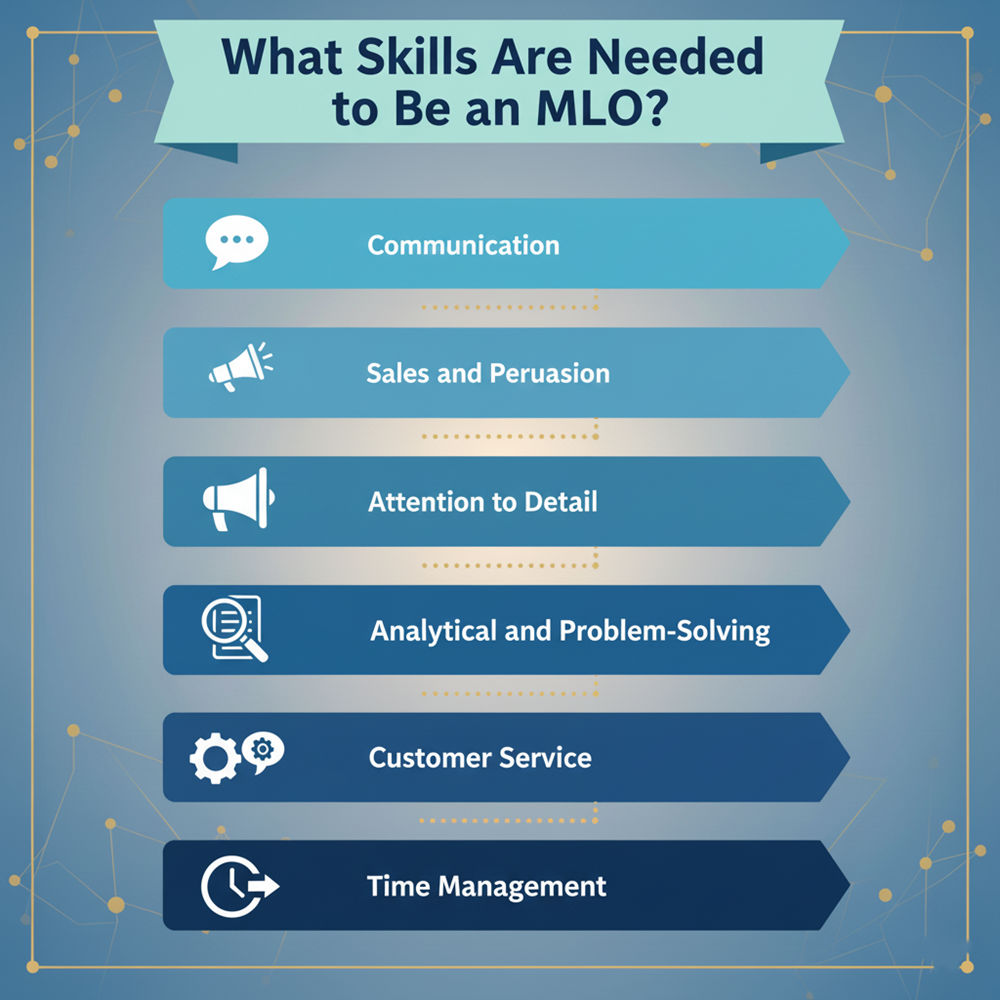Written by
Share this article
Subscribe to updates
Are you looking for a job that offers flexible hours and better with uncapped income potential? That's why people may consider being a loan officer. However, is it hard? What to prepare? You might as well drill down to this ultimate guide and learn how to become a loan officer without experience. Let me walk you through every detail below.
What is a Mortgage Loan Officer?
First of all, let's learn what a loan officer is, their responsibilities, and their average salary.
Definition of a Loan Officer
A loan officer is a licensed professional who helps borrowers navigate the mortgage application process, matches borrowers with appropriate loan products, and submits loan files to underwriting. He/she evaluates borrowers' financial profiles, collects required documentation, runs credit and debt-to-income calculations, and recommends loan products that fit the borrower's goals and eligibility.
Loan officers may also originate loans for a single lender (retail/branch) or work as brokers who shop multiple lenders on behalf of clients. Loan officers operate at banks, credit unions, mortgage lenders, and mortgage brokerages. Some specialize in purchase loans, others in refinance or niche products.
What are the Duties and Responsibilities?
What does a loan officer do? Actually, the typical duties include:
- Interview borrowers
- Collect income and asset documentation (pay stubs, tax returns, bank statements)
- Order credit reports and appraisals
- Prepare and submit the loan application (Form 1003)
- Communicate underwriting conditions
- Coordinate with title/closing
- Educate borrowers on loan types (conventional, FHA, VA, USDA, jumbo, non-QM) and ensure required disclosures are delivered
What is the Salary of Loan Officers?
The BLS lists the median annual wage for loan officers as $74,180 (May 2024). Pay varies widely by employer, market, product mix, and experience. Many originators earn commissions or a salary + commission. Top producers in high-volume markets can earn well above the median.
Public salary aggregators (Glassdoor, Indeed) show higher averages for experienced originators, but those figures reflect different samples and often include top producers and banker compensation packages, so present salary as a range and cite BLS for the median.
How to Become a Mortgage Loan Officer?
Becoming a licensed MLO follows steps set under the SAFE Act and implemented through the NMLS. Here are the typical steps for most U.S. states. State requirements can add additional pieces, so always check the NMLS and your state regulator.
Basic Requirements You Should Know
According to the MLO testing handbook, the minimum eligibility commonly includes:
- Be at least 18
- Have a high school diploma or GED
- Be of good character with no disqualifying criminal offenses
- Have a demonstrably acceptable financial history.
Then, you must create an NMLS account and obtain a Unique Identifier. You should expect state application fees and NMLS processing fees. These vary by state and program. Please always check your state's license page in NMLS for state-specific rules and fees.
Finish Pre-Licensing Education
Before test scheduling, most applicants must complete 20 hours of NMLS-approved pre-licensing education. That 20-hour curriculum typically includes: 3 hours federal law and regulations, 3 hours ethics (fraud, consumer protection, fair lending), 2 hours on non-traditional mortgage lending, plus additional hours covering mortgage origination processes and general mortgage knowledge. Approved course providers report your completion to NMLS.
Pass the SAFE MLO Exam
The SAFE (NMLS) MLO test is the national licensing exam. Current widely used test specs are: 120 multiple-choice questions including 115 scored + 5 unscored pilot questions), 190 minutes testing window, and a passing score of 75%. The exam covers federal mortgage laws, general mortgage knowledge, loan origination activities, ethics, and uniform state content or state component, where applicable. Schedule and take the test through Prometric after completing the education and paying the exam fee.
Complete Background and Credit Checks
NMLS requires FBI-level criminal background checks and fingerprinting, often scheduled through fieldprint/Livescan. Regulators review criminal history and credit reports to assess character and financial responsibility. Convictions for fraud, dishonesty, or certain felonies are often disqualifying.
There are NMLS processing fees and federal background fees. For example, an FBI processing fee commonly shows as about $36.25 on many NMLS pages, but exact fees and additional live-scan or rolling fees depend on your state and vendor. You should always confirm current fees in NMLS before you apply.
Apply for NMLS License
After education, testing, and background checks, apply electronically via the NMLS MU4 (Individual) form. The MU4 collects personal, employment, residential, and disclosure information. Pay the application and state fees in the NMLS portal. processing times vary by state, typically 30–60 days, but sometimes longer. If approved, you'll need a sponsoring lender or broker to activate your origination authority. Your license must be associated with a licensed company before you can take applications in most states.
Get Hired and Gain Experience
Once licensed and sponsored, practical experience is essential. Many new originators start as loan officer assistants, loan processors, or inside sales/relationship banker roles to learn product guidelines, LOS workflows, and underwriting expectations. Seek employers who provide mentorship, pipeline support, and structured ramp programs. This practical exposure accelerates competence far faster than classroom study alone.
Maintain Your License and Continue Learning
NMLS requires a minimum of 8 hours of annual continuing education (CE) for MLOs: 3 hours federal law, 2 hours ethics (fraud, consumer protection, fair lending), 2 hours non-traditional mortgage lending, and 1 hour mortgage origination topics. States may have additional CE or state-specific requirements and SMART deadlines. You should complete CE on time and pay renewal fees via NMLS each year to remain active.

What Skills Are Needed to Be an MLO?
Becoming licensed is the foundation. The skills you cultivate determine whether you succeed. Here are the core competencies and why they matter, summarized from the CE Shop.
- Communication: Loan officers must translate technical lending rules into plain language, manage borrower expectations, and coordinate across real estate agents, underwriters, and title companies. Clear verbal and written communication prevents delays and builds trust.
- Sales and Persuasion: Origination is partly a sales business: you need to generate leads, convert prospects, and maintain referral relationships. Ethical persuasion (educating, comparing options) wins repeat business without resorting to pressure tactics.
- Attention to Detail: Small errors in income calculation or missing disclosures delay closings and risk compliance issues. Meticulous file management avoids surprises during underwriting.
- Analytical and Problem-Solving: Assessing DTI, compensating for appraisal gaps, and structuring loans for unique employment/income situations demands analytical judgment and knowledge of alternate documentation strategies.
- Customer Service: High-touch service, timely updates, and empathy during a stressful purchase, convert clients into repeat customers and referral sources.
- Time Management: Balancing prospecting, active files, and partner relationships requires time-blocking and prioritization. Use process tools to free up time for revenue-producing work.

Tips for You to Become an MLO
There are practical strategies that help new originators accelerate results: generate leads, use tech to automate repetitive tasks, and partner with agents for predictable referral flows.
How to Get Mortgage Leads?
The top sources to get mortgage leads include referrals (past clients, real estate agents, builders), local networking, organic digital marketing (SEO, Google Business Profile), and marketplaces. For new originators, marketplace platforms that match borrowers to verified MLOs can be a high-quality inbound channel.
Bluerate is a mortgage marketplace designed to help borrowers find loan officers and for lenders/LOs to get inbound inquiries and profiles. It's positioned as a low-cost way to build organic leads and professional credibility. As with any lead source, test channels, measure conversion, and nurture contacts.

How to Improve Efficiency?
Modern LOS and automation reduce manual work and speed time to close. Zeitro is an example of an AI-driven loan origination platform that markets faster pre-qualifications, automated 1003 generation, document extraction, guideline search, and pipeline automation, features that can save hours per loan and let originators focus on relationships and underwriting exceptions. Consider adopting an LOS that integrates borrower POS, CRM, and guideline assistance early, it scales your capacity without linear increases in time spent.

FAQs About Being a Loan Officer
Still have problems? Check out the following FAQs and see whether they solve your questions.
Q1. Do loan officers work on weekends?
Yes, many loan officers work evenings or weekends to meet borrower and agent schedules, especially around showings and closing deadlines. Workload peaks during busy market periods. Successful originators set availability boundaries and use tech to streamline after-hours communications.
Q2. Do you need a degree to be a loan officer?
No, a four-year degree is not required. The essential legal requirements are age, basic education (high school/GED), licensing education, passing the SAFE test, and background/credit checks. Degrees in finance, business, or economics can help, but are not mandatory.
Q3. How long does it take to become a loan officer?
Many people complete the licensing steps in 2–4 months if they move quickly: 20 hours pre-licensing, schedule and pass the SAFE exam, complete fingerprints and background checks, submit MU4. State processing and job search time can extend this to 3–6 months in practice.
Q4. Is a loan officer a high-stress job?
It can be: deadlines, regulatory compliance, interest-rate sensitivity, and commission variability create pressure. Good systems, supportive employers, and realistic prospecting plans lower stress. Many originators say the job is rewarding despite spikes of intense work.
Final Word: Is Being a Loan Officer Hard?
Yes and no. The licensing steps are straightforward but non-trivial. Education, testing, and background checks are intended to protect consumers and raise industry standards. The bigger challenge for new originators is building a consistent, quality pipeline (leads) and learning to manage multiple transactions simultaneously. However, with good mentorship, an LOS that automates manual work, and disciplined prospecting, many originators build profitable practices starting from zero experience.
If you're motivated, comfortable with sales and compliance, and willing to learn the guidelines, becoming an MLO is an achievable career change. For new originators, I often recommend:
- Start with strong systems and an LOS to remove repetitive manual tasks. Platforms like Zeitro advertise automation that saves hours per file and speeds pre-quals. This helps new originators scale faster.
- Use marketplaces and profile sites like Bluerate to get inbound borrower inquiries while you build referral networks.
Thousands of people have become successful loan officers with no prior mortgage experience. The combination of licensing, practical training, and consistent business development is the reliable path.




.svg)








